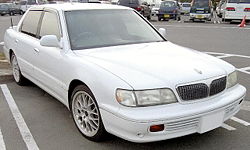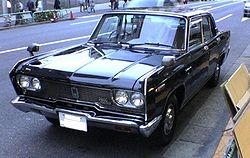- Mitsubishi Debonair
-
Mitsubishi Debonair Manufacturer Mitsubishi Motors Production 1964–1998 Successor Mitsubishi Proudia Body style 4-door sedan Designer Hans Bretzner (1964) The Mitsubishi Debonair is a four-door luxury car, introduced by Mitsubishi Motors in 1964 to serve as their flagship passenger vehicle in the Japanese domestic market. Three distinct generations were available during its 35-year production run until it was discontinued in 1999. The first and second generation models were used by senior level executives of the Mitsubishi Group and affiliated companies, or essentially a Mitsubishi senior executive company car made by the motor vehicle division of Mitsubishi.[citation needed]
Contents
Model history
First generation
The Debonair was Mitsubishi's competitor to the Nissan Cedric and Toyota Crown and during the first generations production, the appearance remained generally unchanged from 1964 - 1986, sharing an appearance tradition with the Toyota Century, that being iconically recognized as a senior executive sedan. Although it received several minor redesigns (denoted I through IV in Roman numerals), the vehicle proved popular enough in the Japanese executive market to remain in production for 22 years without major appearance modifications. The market introduction of the Honda Legend in 1986 influenced many traditional Japanese models to update the appearance of their vehicles, including the Debonair.
Powered by the KE64 1991 cc straight-6 engine with twin carburettors and dual exhausts, it developed 105 PS (77 kW; 104 hp) at 5,000 rpm, and had a maximum speed of 155 kilometres per hour (96 mph). During the 1970s, the Saturn 6 1994 cc straight-6 engine was adopted, boosting power to 132 PS (97 kW; 130 hp) and giving the car a top speed of 180 kilometres per hour (112 mph). Models from the later 1970s onwards were powered by Mitsubishi's Astron 2.6L 4-cylinder engine.
The Debonair was briefly offered in Europe during the 1960s, but demand reduced after Fiat introduced the Fiat 2300.[citation needed]
Second generation
Second generation Also called Hyundai Grandeur Production 1986–1992 Layout FF layout Engine 2.0 L 6G71 V6
3.0 L 6G72 V6
Taxi usage LPG fuelLength 4,865 mm (15.961 ft) Width 1,725 mm (5.659 ft) Height 1,450 mm (4.76 ft) In 1986 the Debonair adopted a front-wheel drive format, a cost effective way to increase interior space without investing money on engineering in an executive sedan. It also came with Mitsubishi's first V6 engines, the 6G71 2.0 L and the 6G72 3.0 L. A supercharged version of the smaller engine was added to the line-up in 1987, using the world's first needle roller rocker arm assembly. This generation, and its successor, were also sold as the Hyundai Grandeur.
Third generation
Third generation 
Also called Hyundai Grandeur Production 1992–1998 Layout FF layout Engine 2.5 L 6G73 V6
3.0 L 6G72 V6 LPG fuel
3.5 L 6G74 V6Transmission INVECS 5-speed semi auto Length 4,980 mm (16.34 ft) Width 1,810 mm (5.94 ft) Height 1,445 mm (4.741 ft) The third model debuted in 1992, longer and wider than its predecessors. The wider range of available engines was now topped by a 260 PS (191 kW; 256 hp) 6G74 3.5 L DOHC V6, and as Mitsubishi's domestic flagship incorporated much of the company's technology, including four-wheel steering, four-wheel anti-lock braking system, electronically controlled suspension, and INVECS automatic transmission with traction control.
It was discontinued in 1999, and directly replaced by the Proudia. However, Mitsubishi also developed its first V8 engine for the new Dignity luxury car around this time, and it was this latter model which took position as the domestic flagship of the company.
External links
- Official history of the Debonair, Mitsubishi Motors South Africa website
Type 1960s 1970s 0 1 2 3 4 5 6 7 8 9 0 1 2 3 4 5 6 7 8 9 Kei sedan Minica Minica 70-73 Minica F4 Minica 5 Minica Ami 55 Minica Skipper Kei truck/ commercial 360 Van/Pickup Minica Van Minica
5 VanMinica 55 Van Minicab Minicab EL Minicab W Minicab 5 Minicab Wide 55 Subcompact 500 Colt 600 Colt 800 Colt 1000F Colt 1100F/11-F Compact Colt 1000 Colt 1100 Colt 1200 Lancer Lancer EX Colt 1500 (Colt) Galant Galant Galant Σ Sport coupé Galant FTO Lancer Celeste Galant GTO Galant Λ Executive Debonair Categories:- Mitsubishi Motors vehicles
- Rear wheel drive vehicles
- Front wheel drive vehicles
- Vehicles with four wheel steering
- Luxury vehicles
- Executive cars
- Sedans
- 1960s automobiles
- 1970s automobiles
- 1980s automobiles
- 1990s automobiles
- Vehicles introduced in 1964
Wikimedia Foundation. 2010.


